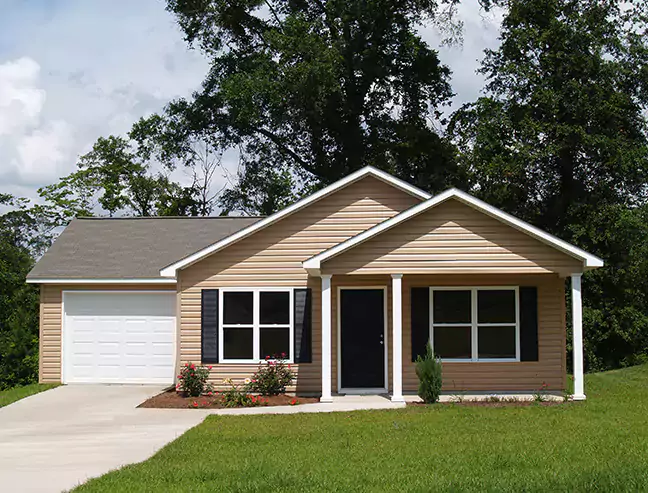At some point in their life, most aging adults will need some sort of assistance with their day-to-day routine. Some individuals have families that are able to care for them, while others may not have that option.
As the elderly population in the U.S. continues to grow, assisted living has become an increasingly popular option for those seeking a comfortable and secure retirement lifestyle. Senior living communities may offer a variety of services that help seniors with daily activities, such as housekeeping, meal preparation, transportation, and medication management. They also exist to provide peace of mind for family members who may not have the resources or time to care for their loved ones at home.
Assisted living costs can vary depending on the location, level of care required, and amenities provided. Yet with the national average being an estimated $4,300 a month, the average senior may find it difficult to afford these services as the majority of them rely on retirement savings, social security, and other sources of income to cover their living costs.
If you are looking for low low-income assisted living arrangement for either yourself or a family member, you have come to the right place. In this blog post, we will walk you through some of the more affordable options in this area.
Does Medicaid Cover Assisted Living?
The simple answer to this is yes. Using the benefits from Medicaid is a very common way to pay for assisted living communities. Even if you are not qualified in the past, you might become eligible for assisted living care as the qualified income limits are raised. Note that the criteria also vary by state.
As Medicaid may only cover a portion of the cost, it can leave you with a significant out-of-pocket expense. As a result, you or your family member may not have access to the level of care and support you need due to financial constraints, which can be a significant challenge for you and your family.
In order to receive full or higher Medicaid coverage for low-income seniors housing, you will have to apply for a different type of Medicaid. And that brings us to the next topic.
Long-Term Care Medicaid
To qualify for affordable senior housing, you need to be eligible for Long Term Care Medicaid. Even if you are a current Medicaid participant, you will still have to apply for this particular category of Medicaid with your caseworker to receive full assisted living coverage.
If you are not a current Medicaid participant, you can still apply for Medicaid affordable assisted living benefits. The best route will be to go through your county, and you can do this via your website in most states. You may be able to start the application process directly online, but some counties may take more time than others to approve. Many Medicaid specialists can help you streamline the process, and it’s a program that is worth looking into as it can be a helpful resource when it comes to paying for assisted listing.
Section 202 Supportive Housing For The Elderly
Section 202 Supportive Housing is a program created in 1995 by the United States Department of Housing and Urban Development (HUD). It was designed for low-income seniors with physical challenges and offers supportive services such as meal preparation, transportation, affordable housing maintenance, etc.
To qualify for Section 202 Supportive Housing, you typically need to pay a rent fee of around 30% of your net income. This means your bill will consist of 30% of your fixed income, social security, social security disability, survivor benefits, and any other income you may be receiving. In other words, the higher your income is, the more you will have to pay.
Other than income, there are other criteria you will have to meet. First, you must be at least 62 years old with an income below 50% of the median income for your area. Second, you must also be able to live independently, which means that you do not require skilled nursing or other specialized care. Some Section 202 communities may have additional eligibility criteria, such as that the applicant must be someone with a disability or who is a veteran. It’s important to check with each community to understand their specific eligibility criteria.
You can fill out an application directly with your housing authority, but note that waiting lists may apply depending on your county, so it’s always a good idea to plan.
Local virtual retirement community
A rather unconventional option for low-income assisted living is a virtual retirement community. And the term is not quite what you may think. Ever since the COVID lockdown, the word virtual may have you picturing some sort of online meeting. But in this case, a virtual retirement community or village refers to a certain community that has agreed to support each other in living comfortable lives. In this type of village, you can offer or receive services from other members or from suppliers that are trusted by the community and essentially contribute to making each other’s lives better.
One of the biggest benefits is that you can live in your own home. Most elderly individuals relocate to an assisted living facility out of necessity rather than want, so the option of having their own housing for as long as possible is appealing to a lot of aging adults.
If you are interested in joining one of these communities, there are resources available to help you find the best ones. You can use tools such as the Village to Village Network Map to connect to communities in and around your area.
Renting Out Your Home
Another very good option that has been rising in popularity is to simply rent out your home and use the money to cover the costs of your assisted living facility. But this is certainly not the least complex way to afford assisted living and will only work if you are the only resident of your current home.
Before going ahead with this plan, you’ll need to determine how much rent you can realistically charge. This will depend on a variety of factors, including the location of your home, its size and condition, and the current state of the rental market in your area. You may want to work with a real estate agent or property management company to help you set the right price. Renting out your home also comes with some risks, such as damage to the property or non-payment of rent by tenants. You’ll need to weigh these risks against the potential benefits of renting out your home.
If you are someone who may be planning for ways to afford your future assisted living fees, there are a multitude of ways you can successfully rent out your home and cover some or most of your costs.
Veterans' Benefits For Assisted Living
There are many benefits for veterans when it comes to living in an assisted living community. One of which is Veterans Administration (VA) aid and assistance, where the Veterans Administration provides you with a sort of monthly allowance for senior living. This can also apply to hospital and general medical care. There are special facilities for veterans known as Veteran Homes and Assisted Living Facilities (VHA). Veterans can receive financial assistance for skilled services and help with daily living with the Veteran-Directed Home and Community-Based Services Program.
If you are qualifying as a veteran, you must have been in active duty for 90 days or more, and at least 1 day during a wartime period. Another requirement for the program is that you had to have been honorably discharged, and some very low-income and age requirements may apply as well. There is more information surrounding the eligibility on the VA website, but it’s best to consult with your local Veterans Affairs office or work with a Veteran’s Benefit Planner to help you along the process.
Note that if you are qualifying as a surviving spouse, in order for you to be eligible for these VA benefits, you have to have been legally married to your spouse before their passing.

Using Life Insurance Policies
Another way to pay for senior living with your resources is to use a life insurance policy to help cover the costs. The Life Care Assurance Benefit program allows you to pay for Assisted living by giving you a long-term care benefit.
By converting part of your life insurance policy into a long-term care benefit, you can get a much higher value than by surrendering it back to the insurance company or letting it lapse. There are a lot of benefits that come with using this asset such as no age or policy size minimum, no wait period or premiums, simple and fast approval, and all types of life insurance accepted.
You can also stop, start, or adjust the benefit however you want to accommodate your needs. The benefit also includes assisted living, home care services hospital visits, and skilled nursing.
In-home Senior Care
In-home care, or home care, refers to any sort of support that allows a senior to safely and comfortably live at home. Caregivers who provide in-home care can be hired directly by the individual or family, or using a home care agency.
One of the main benefits of in-home care is that it allows seniors to receive personalized care in a familiar environment. Many elderly individuals and those with disabilities are hesitant to move into a nursing home or assisted living facility because they want to maintain their sense of independent living and stay in their own homes. In-home care allows them to do so while still receiving the assistance they need.
In-home care can also be more affordable because it is often provided on an hourly basis, and you only pay for the services you need.
Home care is known to be more flexible than other assisted living facilities. Caregivers can work with individuals and their families to create a personalized care plan that meets their specific needs. This can include scheduling care around the individual’s preferred activities and routines, as well as providing care on an as-needed basis.
Note that in-home care may not be appropriate for everyone. Those who require around-the-clock care or specialized medical attention should consider other affordable senior housing options. On top of that, in-home care may not be covered by insurance or Medicaid, so individuals and their families may need to pay for it out-of-pocket.
Assisted Living For Disabled Younger Adults
When a young adult has a disability that affects their ability to live independently, it can be challenging for them and their loved ones to determine the best care options. Luckily, there are assisted living facilities specifically designed to cater to the needs of disabled young adults.
These types of facilities offer a combination of housing, support services, and healthcare to help those with disabilities live as independently as possible while getting the care and assistance they need. They can provide specialized care for individuals with a wide range of disabilities, including physical, developmental, and intellectual conditions. One of the most important benefits of assisted living facilities is that they offer a sense of community and socialization.
Many young adults who struggle with disabilities have trouble finding meaningful social connections and support networks, which can lead to feelings of isolation and loneliness. Living facilities provide a built-in community of peers and caregivers who can offer support, companionship, and social opportunities.
Assisted living facilities also offer a wide range of services to help individuals with daily activities, such as bathing, dressing, and medication management. The level of support provided can vary depending on the individual’s needs and abilities, allowing for a customized care plan that meets their specific requirements. These homes provide access to healthcare services, including on-site medical staff, and rehabilitation services, depending on the type you are participating in. This can be especially important for individuals with complex medical needs or chronic conditions that require ongoing treatment.
Assisted living for the disabled offers a range of housing options, including private apartments, shared living arrangements, and group homes. The choice of housing depends on the individual’s preferences, the level of support required, and the budget. These facilities also provide common areas for meals, social activities, and community events. Note that assisted living facilities for disabled young adults can be expensive as well, and not all insurance policies cover the cost. But resources such as Medicaid and state-funded programs can also offset the cost for young adults.
Staying Connected with FREE UNLIMITED DATA
And if you or any of your family members require assisted living arrangements, you must have reliable mobile phone and data access in case there is a need for emergency services. Moreover, you can also use them to keep track of all the latest news that may apply to your needs, such as the housing choice voucher program and senior apartments. Did you know that you may be eligible for free phone service and data plans through EASY Wireless, thanks to the Affordable Connectivity Program? This program aims to provide affordable and reliable internet and phone access to low-income individuals and families.
The application process is simple and can be completed online or by mail. By providing free cell phone service, the Affordable Connectivity Program seeks to help low-income individuals stay connected with family, friends, potential employers, and vital resources that can improve their quality of life.
When you qualify for this program you can receive:
EASY Wireless Free Unlimited Plan
- FREE UNLIMITED Data & Hotspot
- FREE Unlimited Talk
- FREE Unlimited Text
- Choose to Keep Your Number or Get a New One
- FREE SIM Card & Activation
EASY Wireless offers free monthly cell phone service with unlimited data to eligible customers. It only takes a few minutes to see if you qualify for this free government service. Learn more at EASY Wireless.
You need to remember that in the U.S., there is plenty of help available from different organizations and government programs when it comes to taking care of our disabled and elderly communities. With a bit of research, you will be able to find ways to help yourself or your loved ones settle into a more comfortable living environment.


